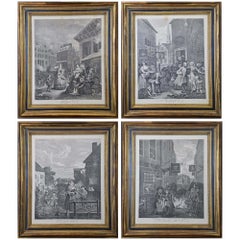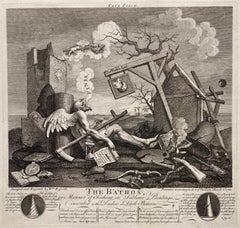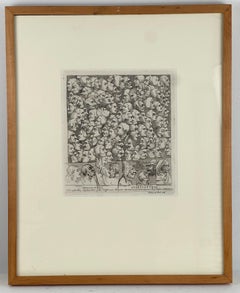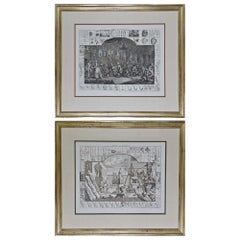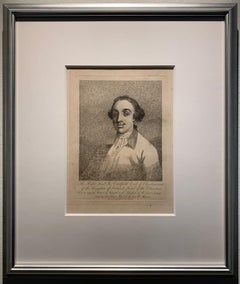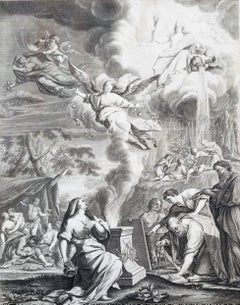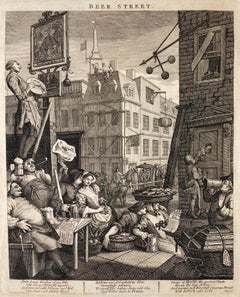William Hogarth Prints and Multiples
British, 1697-1764
William Hogarth (1697-1764) was an English painter, printmaker, pictorial satirist, social critic, and editorial cartoonist. Hogarth's work was extremely diverse, ranging from serious realistic paintings and portraits to satire and moralistic pieces filled with symbolism. He often communicated his moral message in a series of paintings and engravings, such as: A Rake's Progress, Marriage A-la-Mode and A Harlot's Progress. He was by far the most significant English artist of his generation and inspired a movement of English caricaturists and satirists, including James Gillray (1756-1815), Thomas Rowlandson (1757-1827), Isaac Cruickshank (1764-1811) and George Cruickshank (1792-1878). His work has been studied intensely for the greater than two and a half centuries since his death with several academic scholars focusing their careers on the analysis of every element of each of his creations.to
3
1
4
4
Overall Width
to
Overall Height
to
5
13
1,218
958
918
835
7
2
7
5
4
7
5
5
2
2
1
1
1
6
4
1
1
4
1
7
2
Artist: William Hogarth
Four Framed Hogarth Engravings "Four Times of the Day"
By William Hogarth
Located in Alamo, CA
The four plates in this "Four Times of the Day" set were created utilizing both engraving and etching techniques by William Hogarth in 1738. Hogarth's original copper plates were refurbished where needed by James Heath and these engravings were republished in London in 1822 by Braddock, Cradock & Joy. This was the last time Hogarth's original copper plates were used for printing. Most were melted down during World War I for the construction of bombs. Printed upon early nineteenth century wove paper and with large, full margins as published by William Heath in 1822. The inscription below each print reads "Invented Painted & Engraved by Wm. Hogarth & Publish'd March 25. 1738 according to Act of Parliament".
These large folio sized "Four Times of the Day" engravings/etchings are presented in complex gold-colored wood frames with black bands and scalloped gold inner trim. A majority of each thick impressive frame is covered with glass applied near the outer edge. Each frame measures 25.75" high, 22.25" wide and 1.88" deep. There are a few small dents in the edge of these frames, which are otherwise in very good condition. "Morning" has two focal areas of discoloration in the upper margin and some discoloration in the right margin, a short tear in the left margin and a short tear or crease in the right margin. "Noon" has a spot in the upper margin that extends into the upper image, but it is otherwise in very good condition. "Evening" has a faint spot in the upper margin, but it is otherwise in very good condition. "Night" is in excellent condition.
The "Four Times of the Day" series is in the collection of many major museums, including: The British Museum, The Metropolitan Museum of Art, The Tate Museum, The Chicago Art Institute and The Victoria and Albert Museum.
Through this series Hogarth is portraying early 18th century London street life at "Four Times of the Day". His characters are exhibiting their personalities, quircks, strange activities, but he also wants to draw attention the disparities between the wealthy aristocracy and the common working class.
Plate 1, "Morning" depicts morning in Covent Garden in the winter in front of Tom King...
Category
Mid-18th Century Old Masters William Hogarth Prints and Multiples
Materials
Engraving, Etching
$5,420 Sale Price
20% Off
BATHOS / Tail PIece
By William Hogarth
Located in Santa Monica, CA
WILLIAM HOGRATH (1767- 1764)
THE BATHOS / Tail Piece 1764 (Paulson 1989: 216 I/I Paulson 1965/70: 216 I/I)
Engraving Plate 12 7/8 x 13 3/8, sheet 17 ¾ x 18 ¾ Designed & Engrav’d by Wm Hogarth at left and Published according to Act of Parliam’t March 3, 1764 at right. Good condition on thick laid paper Small bit of tape on the left & right sheet edges small stan lower sheet edge all on recto.
This Hogarth’s last print is fascinating as it is prophacy about death.
Various institutions have interesting commentaries - to wit:
Chicago Art Institute: Hogarth created The Bathos toward the end of his life. It is considered one of the bleakest artworks of the 18th century because it depicts the Apocalypse without an afterlife. The Angel of Death even collapses in exhaustion after having destroyed the world. In his hand is an execution decree and around him lies a mass of broken objects.
Princeton: Hogarth’s last print, The Bathos,….. is filled with all manner of images denoting the end of life as we know it. Entry no. 216 in Ronald Paulson’s catalogue raisonne Hogarth’s Graphic Works, 3rd revised edition says “This print is the culmination of such pessimistic images . . . . [taking] his general composition, the configuration of objects, and some of the particular items, from Dürer’s engraving, Melancholia; but he also recalls Salvator Rosa’s Democritus in Meditation (which derives from Dürer’s print) with a scroll at the bottom of the etching: ‘Democritus the mocker of all things, confounded by the ending of All Things’ (Antal, p.168).”
Newfields (Indianapolis Museum of Art): Hogarth intended this engraving to serve as the tailpiece to bound volumes of his collected engravings and, appropriately, it proved to be his last engraving. Father Time has died and his last will and testament has been witnessed by the three Fates. He is surrounded by a landscape of death, decay, and ruin. Hogarth aimed this print at dealers in “dark” Old Masters paintings who promoted the idea that ruins evoked sublime feelings in viewers—a sentiment, Hogarth wrote, that was reducing the world to ruin.
British Caricature...
Category
1760s Old Masters William Hogarth Prints and Multiples
Materials
Woodcut
Character vs. Charicature
By William Hogarth
Located in Wilton Manors, FL
William Hogarth (1697-1764).
Character vs. Charicature, 1743.
Engraving on laid paper, plate measuring 8.25 x 9.25 inches. Framed measurement: 16.25 x 20.25 inches.
Characters and...
Category
Mid-18th Century Realist William Hogarth Prints and Multiples
Materials
Engraving
William Hogarth's "Analysis of Beauty": A Set of Two Framed 18th C. Engravings
By William Hogarth
Located in Alamo, CA
The two plates in this set were created utilizing both engraving and etching techniques by William Hogarth in 1753, originally as illustrations of his book on aesthetics, entitled "Analysis of Beauty". Due to their popularity, these plates were later published separately. The publication line in the lower right reads: "Designed, Engraved, and Publish'd by Wm. Hogarth, March 5th 1753, according to Act of Parliament." Hogarth's original copper plates were refurbished where needed by James Heath and engravings were republished in London in 1822 by Braddock, Cradock & Joy. This was the last time Hogarth's copper plates were used for printing. Most were melted during World War I for the construction of bombs.
These large folio sized "Analysis of Beauty" engravings are presented in antiqued gold-colored frames with double mats; the outer silk mats are light brown-colored and the inner mats are dark brown. Each frame measures 27.38" x 31.25" x 1.13". There is one tiny spot in the right margin of plate 1 and another in the lower margin; the latter could be from the printing process. The prints are otherwise in excellent condition.
The "Analysis of Beauty" series is in the collection of many major museums, including: The British Museum, The Metropolitan Museum of Art, The Tate Museum, The Chicago Art Institute and The Fine Arts Museums of San Francisco.
The first engraving (Plate 1) depicts a courtyard of statues which is filled with some of the most famous works of classical sculpture. The most important sculptures are surrounded by less impressive works. The Medicean Venus (#13) is in the center with a statue of Julius Caesar (#19) to the right, elevated on a pulley with a short, overdressed Brutus stands over the falling Caesar. The Apollo Belvedere (#12) is next. A judge stands to the right with his foot on a cherub (#16). Another crying cherub holds a gallows and wipes his tears with the judge's robe.
A sphinx (#21) and the drunken Silenus (#107) are below the Venus. Michaelangelo's torso (#54) and a statue of Antonius (#6) are seen in the foreground. The Farnese Hercules (#3) and a bust of another Hercules (#4) under two statuettes of Isis are also included in the scene.
The key to these objects is included in the form of a serpentine line winding around a cone (#26), Hogarth's "Line of Beauty". For Hogarth the winding line is an essential element of beauty in art. Hogarth's theory of beauty is communicated in this plate.
Plate 2 is thought to represent the Wanstead Assembly, with the Earl of Tynley and his household. It is an adaptation of a scene in the Happy Marriage series, which complements Hogarth's Marriage à la Mode...
Category
Mid-18th Century Old Masters William Hogarth Prints and Multiples
Materials
Engraving, Etching
'Portrait of James Caulfield' by William Hogarth, Etching
By William Hogarth
Located in Oklahoma City, OK
This 21" x 18" etching was produced by William Hogarth in the mid-18th century. The work has been newly matted and framed with archival materials. The subject, identified as James Caulfield, 4th Viscount, 1st Earl of Charlemont (1728-1799), became commander in chief of the Irish Volunteers...
Category
1780s Realist William Hogarth Prints and Multiples
Materials
Etching
William Hogarth . Original engravings 155 pсs., 1 piece with blend. 1822 London
By William Hogarth
Located in Riga, LV
William Hogarth (1697-1764)
Original engravings 155 pсs., 1 piece with blend. 1822 London
From A. Neibergs collection
Category
1820s Realist William Hogarth Prints and Multiples
Materials
Paper, Engraving
The Industrious Prentice - Etching by William Hogarth - 1747
By William Hogarth
Located in Roma, IT
The Industrious Prentice - Lord Mayor of London is an original etching print realized by William Hogarth in 1747
Signature on the plate on the lower right, with the description on t...
Category
1740s Old Masters William Hogarth Prints and Multiples
Materials
Etching
"The Beggars Opera" and " A Just View of The British Stage" Original Etchings
By William Hogarth
Located in Houston, TX
The original design for the top half was formally attributed to William Hogarth, according to the Met Museum, and published by John Bowles in 1728. The edition here has a second half...
Category
1820s Baroque William Hogarth Prints and Multiples
Materials
Etching
"A Harlot's Progress" Plate 3 Etching
By William Hogarth
Located in Houston, TX
Etching from the series titled "A Harlots Progress" by William Hogarth. The series consists of six paintings and engravings. The story is about a woman named M. Hackabout who arrived in London and started working as a prostitute. The third plate is of her getting arrest for her choice in profession. The series is a satirical story that emphasizes the dangers of being a prostitute and the health risks that come from it.
In 18th century engraving, the detail of the black mole on women and men's face is a symbol of the deadly venereal disease, syphilis. In this plate, Hackabout has already contracted the disease and that is why the black dot is visible on her forehead as well as her madam's.
In 1828, William Innell Clement published Harlot's Progress in columns on a single page of his newspaper Bell's Life in London #330. The detail with the cross seen in earlier reproductions of the engraving.
Dimensions without Frame: H 14.5 in x W 16.5 in.
Artist Biography: William Hogarth ( 10 November 1697 – 26 October 1764) was an English painter, printmaker, pictorial satirist, social critic, and editorial cartoonist. His work ranged from realistic portraiture to comic strip-like series of pictures called "modern moral subjects", perhaps best known to be his moral series A Harlot's Progress, A Rake's Progress and Marriage A...
Category
1730s Old Masters William Hogarth Prints and Multiples
Materials
Etching
Related Items
Aurora sive Tempus Matutinum; Der Wohl und Übel angewandte Morgen /// Old Master
Located in Saint Augustine, FL
Artist: (after) Johann Daniel Preissler (German, 1666-1737)
Title: "Aurora sive Tempus Matutinum; Der Wohl und Übel angewandte Morgen (Dawn or Morning Time; The Morning Used for Better or For Worse)"
Portfolio: Die Vier Tageszeiten (The Four Times of Day)
Year: 1723
Medium: Original Etching and Engraving on laid paper
Limited edition: Unknown
Printer: likely Johann Balthasar Probst, Augsburg, Germany
Publisher: Jeremias Wolff (Erben), Augsburg, Germany
Reference: Le Blanc No. 255, 38; Nagler No. 23
Sheet size: 22.57" x 16.38"
Image size: 17.75" x 14"
Condition: Soft handling creases, folds, and scattered faint areas of discoloration to sheet. Three tears skillfully repaired from verso. Has been professionally stored away for decades. It is otherwise a strong impression in good condition with full margins
Extremely rare
Notes:
Provenance: private collection - Aspen, CO. Engraved by German artist Johann Balthasar Probst (1673-1750) after a drawing by German artist Johann Daniel Preissler (1666-1737). Comes from Preissler's 1723 "Die Vier Tageszeiten (The Four Times of Day)" portfolio of four etchings and engravings. Printed from one copper plate in one color: black. Descriptions of the portrayed image are printed in Latin and German.
Biography:
Johann Daniel Preissler, or Preisler (1666–1737) was a German painter and director of Nuremberg's Academy of Fine Arts. He was a notable member of a German artistic family, originating in Bohemia. His children included Johann Justin Preissler (1698–1771), Georg Martin Preisler (1700–1754), Barbara Helena Preisler (1707–1758; married to Oeding), Johan Martin Preisler (1715–1794), and Valentin Daniel Preisler (1717–1765), all in their time renowned artists. Most notable for his portraits, nudes and history paintings, Johann Daniel Preissler also produced drawings and frescoes. He was particularly known beyond his native Nuremberg for his "Die durch Theorie erfundene Practic", a sequence of works on art theory – the individual works were translated into several other languages and served as textbooks for students such as the Swiss Salomon Gessner...
Category
1720s Old Masters William Hogarth Prints and Multiples
Materials
Laid Paper, Engraving, Etching
$900
H 22.57 in W 16.38 in
Self Portrait With Children - Original woodcut (Buisson #60.109)
By Léonard Tsuguharu Foujita
Located in Paris, IDF
Leonard Tsuguharu FOUJITA
Self Portrait With Children, 1960
Original woodcut
On vellum 37 x 28 cm (c. 15 x 11 in)
REFERENCES : Catalogue Raisonne Sylvie Buisson #60.109
Excellent ...
Category
1960s Realist William Hogarth Prints and Multiples
Materials
Etching
$900
H 14.57 in W 11.03 in
"King of the Friendly Islands" (Tonga); Engraving from Captain Cook's 3rd Voyage
By John Webber
Located in Alamo, CA
"Poulaho, King of the Friendly Islands, Drinking Kava" is an engraving created by William Sharp (1749-1824), from a drawing by John Webber (1752-1793), who was the artist on Captain James Cook's 3rd and final voyage of discovery. It was published in the atlas of "A Voyage to the Pacific Ocean Undertaken by the Command of His Majesty, for Making Discoveries in the Northern Hemisphere", the official British Admirality sanctioned journal published upon completion of the voyage in London in 1784 by Strahan & Cadell.
Captain Cook visited Tonga on his 3rd voyage, which he named The Friendly Islands because of the warm welcome he and his crew received, unlike some of the other more hostile Pacific islands. The engraving depicts Cook and his men observed a kava ceremony at the village of Mu’a on Tongatapu. King Paulaho sits in the centre foreground, his back to the spectator with a man kneeling before him. The ceremonial mat depicted behind Paulaho indicates that nobody was allowed to sit behind him. The figure in the centre holds a single cup, referring to the Tongan custom of offering the cup to the king first. Kava is native to the islands of the South Pacific and was first described for English readers in 1768 by Captain James Cook. The kava root has been used for centuries as a central feature of ceremonies and celebrations because it was able to bring about a calming and pleasant social atmosphere. The root was crushed and processed into coconut milk to become the focal ceremonial beverage, simply referred to as kava.
This engraving is presented in a Koa wood frame and a white mat. Koa wood is legendary in Hawaii. There are occasional faint spots, but the print is otherwise in very good condition. This amazing Koa wood is native to Hawaii and it is known for the deep rich colors and varied grain pattern. Koa has an honored heritage in Hawaii and is highly revered and sacred. The word “koa” means “warrior” in Hawaiian. The warriors of King Kamehameha the Great, created canoes and weapons from a wood plentiful on the Big Island of Hawaii. This wood became synonymous with the warriors themselves, and it became known as koa.
There are three other engravings listed from the official journal of Captain Cook's 3rd voyage available that are presented in identical Koa wood frames and mats (LU117324682422, LU117324684052, LU117324684032). They would make a wonderful grouping for a display of 2, 3 or 4 prints. A discount is available for a grouping depending on the number of items included.
Captain Cook is remembered as one of the greatest explorers and navigators in history. His explorations included Australia, New Zealand and islands of the South Pacific and the northwest coast of North America. Hawaii was discovered by Captain Cook during this voyage. Hawaii was originally called The Sandwich Islands in honor of The Earl of Sandwich...
Category
1780s Realist William Hogarth Prints and Multiples
Materials
Engraving
$1,900 Sale Price
20% Off
H 18.25 in W 23.5 in D 0.88 in
Tolosa (Toulouse); Leaf LXXI from Hartmann Schedel's Nuremberg Chronicle
Located in Middletown, NY
Woodcut on laid paper, 8 3/8 x 9 1/8 inches (212 x 233 mm), the full sheet. In excellent condition with text and portraits of Empedocles, Sapho, Zeuxis and others on the verso, as is...
Category
15th Century and Earlier Old Masters William Hogarth Prints and Multiples
Materials
Ink, Handmade Paper, Laid Paper, Woodcut
Sportsmen
By Louis Legrand
Located in Storrs, CT
Sportsmen. 1908. Etching and drypoint. Exsteens 271.i/ii. 11 1/4 x 5 3/4 (sheet 17 3/8 x 12 1/4). Series: Les Bars. From the first state edition of 30 proofs with the remarque sketch...
Category
Early 1900s Post-Impressionist William Hogarth Prints and Multiples
Materials
Drypoint, Etching
'Jesus and the Woman at the Well, ' by Amand-Durand, Engraving
By Armand Durand
Located in Oklahoma City, OK
This early 19th century framed 35" x 31" engraving by artist Amand-Durand depcits an etching of 'Jesus and the Woman at the Well,' after the Dutch master, Rembrandt van Rijn. This poignant Biblical story is depicted by Arman-Durand in Rembrandt style...
Category
Early 19th Century Old Masters William Hogarth Prints and Multiples
Materials
Engraving
$1,200 Sale Price
20% Off
H 30.5 in W 26.5 in D 1.5 in
The Triumph of Caesar: Plate IV of IX
By Andrea Mantegna
Located in Middletown, NY
Andreani, Andrea, after Andrea Mantegna
The Triumph of Caesar: Plate IV of IX
1599. Chiaroscuro woodcut in colors printed from four blocks on laid paper in dark brown, grey, and thr...
Category
16th Century Old Masters William Hogarth Prints and Multiples
Materials
Handmade Paper, Laid Paper, Ink, Woodcut
S. LOEB (SOLOMON LOEB)
By Anders Zorn
Located in Portland, ME
Zorn, Anders. S. LOEB (SOLOMON LOEB). H&H76, Asplund 115, Delteil 113. Etching, 1897. Unsigned (signed in the plate). Apparently the 2d or 4th State of 4. All of the states are descr...
Category
Late 19th Century Realist William Hogarth Prints and Multiples
Materials
Etching
Don Juan
By Louis Icart
Located in Missouri, MO
Aquating Engraving
Image Size: approx. 20 1/4 x 13 3/8
Framed Size: 28 x 20.5 inches
Pencil Signed Lower Right
Louis Justin Laurent Icart was born in Toulouse in 1890 and died in Paris in 1950. He lived in New York City in the 1920s, where he became known for his Art-Deco color etchings of glamourous women.
He was first son of Jean and Elisabeth Icart and was officially named Louis Justin Laurent Icart. The use of his initials L.I. would be sufficient in this household. Therefore, from the moment of his birth he was dubbed 'Helli'. The Icart family lived modestly in a small brick home on rue Traversière-de-la-balance, in the culturally rich Southern French city of Toulouse, which was the home of many prominent writers and artists, the most famous being Henri de Toulouse-Lautrec.
Icart entered the l'Ecole Superieure de Commerce de Toulouse in order to continue his studies for a career in business, particularly banking (his father's profession). However, he soon discovered the play writings of Victor Hugo (1802-1885), which were to change the course of his life. Icart borrowed whatever books he could find by Hugo at the Toulouse library, devouring the tales, rich in both romantic imagery and the dilemmas of the human condition. It was through Icart's love of the theater that he developed a taste for all the arts, though the urge to paint was not as yet as strong for him as the urge to act.
It was not until his move to Paris in 1907 that Icart would concentrate on painting, drawing and the production of countless beautiful etchings, which have served (more than the other mediums) to indelibly preserve his name in twentieth century art history.
Art Deco, a term coined at the 1925 Paris Exposition des Arts Decoratifs, had taken its grip on the Paris of the 1920s. By the late 1920s Icart, working for both publications and major fashion and design studios, had become very successful, both artistically and financially. His etchings reached their height of brilliance in this era of Art Deco, and Icart had become the symbol of the epoch. Yet, although Icart has created for us a picture of Paris and New York life in the 1920s and 1930s, he worked in his own style, derived principally from the study of eighteenth-century French masters such as Jean Antoine Watteau, François Boucher and Jean Honoré Fragonard.
In Icart's drawings, one sees the Impressionists Degas...
Category
1920s Art Deco William Hogarth Prints and Multiples
Materials
Engraving, Aquatint
Ancient Roman Architecture: Original Framed 18th C. Etching by G. Piranesi
By Giovanni Battista Piranesi
Located in Alamo, CA
"Veduta del Sepolcro della Famiglia Plauzia per la Strada Che Conduce da Roma a Tivoli vicino a Ponte Lugano" from "Le Antichità Romane" (Roman Antiquities), one of the most famous works by Piranesi. "Antichita" illustrates the tombs along the Appian Way...
Category
Early 18th Century Old Masters William Hogarth Prints and Multiples
Materials
Etching, Engraving, Drypoint
$3,100 Sale Price
20% Off
H 24.38 in W 31.75 in D 0.75 in
The Triumph of Caesar: Plate IV
By Andrea Mantegna
Located in Middletown, NY
Andreani, Andrea (Italian, about 1558–1610), after Andrea Mantegna (Italian, 1431-1506)
Chiaroscuro woodcut in colors printed from four blocks on laid paper in dark brown, grey, and...
Category
16th Century Old Masters William Hogarth Prints and Multiples
Materials
Ink, Handmade Paper, Laid Paper, Woodcut
A Hebrew nomadic camp – English School, 18th century
Located in Middletown, NY
Engraving on light weight laid paper with an small indiscernible, alphabetic watermark, 9 x 7 1/2 (230 x 188 mm); sheet 11 1/4 x 8 1/2 inches (284 x 215 mm), wide margins. In very go...
Category
18th Century Old Masters William Hogarth Prints and Multiples
Materials
Ink, Handmade Paper, Laid Paper, Woodcut
Previously Available Items
BEER STREET
By William Hogarth
Located in Santa Monica, CA
WILLIAM HOGARTH (BRITISH 1675 – 1764)
BEER STREET 1751(Paulson 185 iii/iii)
Etching and engraving Design’d by W, Hogarth lower left, Publish’d according to act of Parliament...
Category
1750s Old Masters William Hogarth Prints and Multiples
Materials
Engraving, Etching
Mr. Garrick in the Character of Richard the 3rd - FINE IMPRESSION
By William Hogarth
Located in Santa Monica, CA
WILLIAM HOGRTH (1697 - 1764)
MR. GARRICK IN THE CHARACTER OF RICHARD THE 3RD (Shakespear Act 5 Scene 7)
(Paulson 1970.165 ii/ii; Paulson 1989.165 ii/ii;, Dobson and Armstrong p. 20...
Category
1740s Old Masters William Hogarth Prints and Multiples
Materials
Engraving, Etching
"Principal Inhabitants of the Moon": A Framed 18th Century Satire by Hogarth
By William Hogarth
Located in Alamo, CA
This is a framed original satirical etching/engraving by William Hogarth, entitled "Some Principal Inhabitants of ye Moon: Royalty, Episcopacy and Law", originally published in London in 1760.The inscription reads: ""Some of the principal inhabitants of [the] moon as they were perfectly discover'd by a telescope brought to [the] greatest perfection since [the] last eclipse; exactly engraved from the objects whereby [the] curious may guess at their religion, manners, &c.". Although this may be an original life-time printing, it may have been published by Baldwin Craddock and Joy in London in 1822 from Hogarth's original copper plate that was reworked where needed by Heath, referred to as the Heath edition. This publication was the last time that Hogarth's plates were used for a printing. Most were subsequently destroyed and those remaining are primarily held by institutions.
The scene is presented within a circle, as if seen through a telescope viewing the moon, surrounded by a square border, under which is engraved the title. The figures, who are satirically supposed to be the inhabitants of the moon, sit on a wooden platform suspended above the clouds. Three seated figures are supposed to represent the "Monarchy, Episcopacy, and Law". "Monarchy", representing royalty, sits on a throne wears a crown and he holds a globe and a sceptre. His face is a gold coin. The symbol of perpetuity, is embroidered on the cloth under his throne.
"Episcopacy", representing the church, is operating a pump by pulling on a bell-rope fastened around a bible attached to the pump handle. The pump pours out money into a chest representing the church coffers and wealth. The chest is decorated with an armorial escutcheon, containing a knife and fork, topped by a church leader's mitre. Episcopacy's face is a Jew’s Harp and his right foot rests on a pile of three cushions. A cloven foot is seen protruding from under his religious robe.
"Law" wears the type of wig worn by 18th century English judges. He holds a large sword on the right, but he does not appear to have a left arm. His face is a hammer resembling that of the Viking god Thor. Behind him a dagger appears to be thrust through the bottom of a sieve.
The bodies of the attendants on Monarchy are composed of circular fire-screens, resembling shields. The trunks of the Courtiers are large looking-glasses, the sconces, with candles in them serving for hands and arms. The face of the chief of these is the reverse of a sixpence; and a key significantly appended to his sash at once denotes his sex and office. Under the figure of Law are a male and female modishly dressed. Her head is a tea-pot, her neck is a drinking-glass and her body is a half open fan. The male figure's face is a coat of arms and his legs are fan sticks. He appears to be courting the female.
There is a great deal of satirical symbolism in this print and their meaning is not always obvious. Hogarth may have planned to include an explanation since there are letters a, b, c, d, e, f and g placed over or under some of the figures and objects. The reference books by Ronald Paulson, such as "Hogarth's Graphic Works, provide some possible interpretations.
The print is presented in an ornate glossy black wood frame with beaded gold-colored outer and inner trim, a beaded gold-colored fillet and a cream-colored silk mat. There is a small defect in the frame's right upper edge. The print was not examined out of the frame, but the visible portions of the print are in excellent condition. The frame and mat style are identical to another old master print listed on 1stdibs, a 17th century portrait of the old master artist Petrus de Jode by Anthony van Dyck. This print can be viewed by placing the 1stdibs reference # LU117327129592 in the search field. These two framed prints would make a striking display grouping. A discount is available for purchase of the pair.
Artist: William Hogarth (1697-1764) was an English painter, printmaker, pictorial satirist, social critic, and editorial cartoonist. Hogarth's work was extremely diverse, ranging from serious realistic paintings and portraits to satire and moralistic pieces filled with symbolism. He often communicated his moral message in a series of paintings and engravings, such as: A Rake's Progress, Marriage A...
Category
Mid-18th Century Old Masters William Hogarth Prints and Multiples
Materials
Engraving, Etching
H 22 in W 19 in D 1.13 in
"The Enraged Musicians" Original Baroque Etching
By William Hogarth
Located in Houston, TX
The print was published as a companion to the ‘Distressed Poet’, the original of which is in the City Museum and Art Gallery, Birmingham. When advertising its publication in the pres...
Category
1820s Baroque William Hogarth Prints and Multiples
Materials
Etching
"The Beggar's Opera Act III" Original Barque Etching
By William Hogarth
Located in Houston, TX
William Hogarth's illustration of John Gay's "The Begger's Opera". In this plate, the character of Macheath stands in the center shackled. On either side of him is his lover and wife...
Category
1820s Baroque William Hogarth Prints and Multiples
Materials
Etching
William Hogarth (1697–1764) - 1746 Engraving, Mr Garrick, Richard the Third
By William Hogarth
Located in Corsham, GB
A very fine 18th century copper plate engraving from William Hogarth and Charles Grignion (1721–1810). Hogarth depicts his close friend, the actor David Garrick, as Richard III wakin...
Category
18th Century William Hogarth Prints and Multiples
Materials
Engraving
An Election Entertainment - Original Etching by William Hogarth - 1755
By William Hogarth
Located in Roma, IT
An Election Entertainment is an original etching realized by William Hogarth in 1755. The etching was engraved also by Francois Morellon de la Cave.
Original title: An Election Entertainment, Plate I: Four Prints of an Election.
Signature on plate: "Painted and the Whole Engraved by Wm. Hogarth. / Published 24th Febry. 1755, as the Act directs".
Inscription on plate: "To the Right Honourable Henry Fox, &c. &c. &c. This plate is humbly Inscrib'd by his most Obedient Humble Servt. Wm. Hogarth".
Includes passepartout and frame (62 x 2 x 74 cm).
Good conditions, except for a browning of paper due to the signs of aging.
The print is from the series The Humours of an Election (1754-58), the artist's last painted cycle regarding contemporary affairs. The paintings are now in Sir John Soane's Museum, London.
Unlike the other three engravings in the series, An Election Entertainment does not reverse the original painting, as in the case of when Hogarth made engravings...
Category
1750s Old Masters William Hogarth Prints and Multiples
Materials
Etching
H 16.93 in W 22.05 in D 0.04 in
The Polling - Original Etching by William Hogarth - 1758
By William Hogarth
Located in Roma, IT
The Polling is an original etching realized by William Hogarth in 1758. The etching was engraved also by Francois Morellon de la Cave.
Original title: The Polling, Plate III: Four Prints of an Election.
Signature on plate: "Engrav'd by W. Hogarth & Le Cave...
Category
1750s William Hogarth Prints and Multiples
Materials
Etching
H 16.93 in W 22.05 in D 0.04 in
The Sleeping Congregation.
By William Hogarth
Located in Storrs, CT
1736 (Heath Edition 1822). Etching and engraving. Paulson 140 iv/iv; British Museum Satires 2285. 10 1/2 x 8 3/16 (sheet: 12 7/8 x 9 3/4). Inscription: in plate below image, lower le...
Category
1730s Old Masters William Hogarth Prints and Multiples
Materials
Engraving, Etching
William Hogarth prints and multiples for sale on 1stDibs.
Find a wide variety of authentic William Hogarth prints and multiples available for sale on 1stDibs. You can also browse by medium to find art by William Hogarth in etching, engraving, woodcut print and more. Much of the original work by this artist or collective was created during the 18th century and is mostly associated with the Old Masters style. Not every interior allows for large William Hogarth prints and multiples, so small editions measuring 13 inches across are available. Customers who are interested in this artist might also find the work of Samuel & Nathaniel Buck, John Thomas Smith, and Giovanni Battista Tiepolo. William Hogarth prints and multiples prices can differ depending upon medium, time period and other attributes. On 1stDibs, the price for these items starts at $350 and tops out at $5,420, while the average work can sell for $737.
